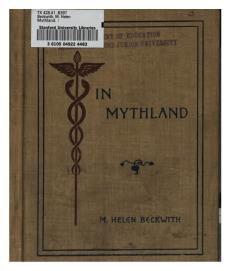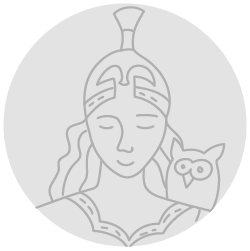Title of the work
Country of the First Edition
Country/countries of popularity
Original Language
First Edition Date
First Edition Details
Mary Helen Beckwith, In Mythland. Boston, New York and Chicago: Educational Publishing Company, 1896, 205 pp.
ISBN
Available Onllne
In Mythland at Archive.org (accessed: August 2, 2022).
Genre
Anthology of myths*
Fiction
Picture books
Target Audience
Children (kindergarten children, young children, early readers)
Cover

Cover retrieved from Internet Archive (accessed: August 2, 2022), public domain.
Author of the Entry:
Robin Diver, University of Birmingham, robin.diver@hotmail.com
Peer-reviewer of the Entry:
Susan Deacy, University of Roehampton, s.deacy@roehampton.ac.uk
Daniel A. Nkemleke, University of Yaoundé 1, nkemlekedan@yahoo.com

Mary Helen Beckwith (Author)
Mary Helen Beckwith was an author of educational texts for children: When First We Go to School, In Mythland (1896) and Lesson Plans: Domestic Animals (c. 1907). The dedication and preface to In Mythland suggests she may have been a kindergarten teacher herself. The words ‘Florence Kindergarten’ appear beneath her name at the end of the preface; this may mean that she lived and taught in Florence, Massachusetts, an area where her illustrator Susanne Lathrop was also active.
Sources:
ThriftBook (accessed: August 2, 2022).
The Online Books Page (accessed: August 2, 2022).
Bio prepared by Robin Diver, University of Birmingham, robin.diver@hotmail.com

Susanne Lathrop
, 1860 - 1938
(Illustrator)
Susanne Lathrop (b.1860, Savannah, Georgia) was one of the Lathrop sisters – artists and teachers based in Northampton, Massachusetts. She was the daughter of Henry Lathrop, a merchant, and Clara Stebbins Lathrop, a philanthropist for the elderly and disabled. She studied at Smith College, the Académie Julian in Paris and the Pennsylvania Academy of the Fine Arts. Together with her sisters Clara and Bessie, she travelled Europe and Canada painting, gave private art lessons and taught at various schools.
Her art style was mainly watercolour and pen and ink. Her work was exhibited at the Art Institute of Chicago (1889), American Water Color Society (1889, 1892, 1893), Boston Art Club (1890, 1891) and Art Club of Philadelphia (1892). Her local scenery sketches appeared in Picturesque Hampshire and The History of Florence, Massachusetts.
Sources:
AskArt Biography (accessed: August 2, 2022).
Wikipedia (accessed: August 2, 2022).
Bio prepared by Robin Diver, University of Birmingham, robin.diver@hotmail.com
Summary
This is a collection of Greek myths for kindergarten children, retold in very simple language using poetry verse lines (although the lines do not rhyme). The stories are lightly told, with disturbing details obscured, and there is a focus on child characters. It is illustrated throughout with line drawings, often showing one of the main characters contemplating something.
Featured Stories:
- Epimetheus and Pandora,
- How Daphne Became a Tree,
- Aeolus, the Keeper of the Winds,
- Latona and the Frogs,
- Theseus, the Brave,
- The Little Weaver (Arachne),
- Midas’ Touch,
- Clytie, a Sunflower Myth,
- Vulcan, the Mighty Smith,
- Ceres and Proserpina,
- Arion, the Musician,
- Baucis and Philemon.
Analysis
This anthology begins with a dedication to ‘The Kindergarten children who have enjoyed the stories’. The preface is addressed to ‘My dear little friends’, and introduces the ancient Greeks as a people who ‘did not know much about (…) the little country in which they lived; and (…) had many queer ideas.’ The myths, Beckwith tells us, were created to explain what the Greeks did not understand, and Beckwith imagines a Greek father telling his son ‘We must be kind and loving, my boy, like the dear gods.’
Greek myths are thus envisioned as simple but charming primitive science about benevolent deities who provided a moral exemplar to Greek children. Beckwith ends by reassuring her readers that the true religion of Christianity is ‘a more beautiful story’ than Greek myth, but that these are still pretty stories. She signs herself off as ‘Sincerely your friend, M. Helen Beckwith’.
Consistent with the address to kindergarten children, this anthology is obviously aimed at very young children. The language is simple, the text widely spaced and frequently broken up with illustrations.
Beckwith makes many similar creative choices to Hawthorne’s influential 1851 A Wonder Book for Girls and Boys and 1853 Tanglewood Tales anthologies, focusing on family themes and child characters, and adding children into the story where they were not present in ancient versions. Pandora and Epimetheus are children, as in Hawthorne, Pluto abducts the child Proserpina because he is lonely and needs a sweet little girl to brighten his home as in Hawthorne, and Midas has a daughter called Marygold who he accidentally transforms, as in Hawthorne.
Beckwith also gives very little context to what is shown taking place. In the Arachne retelling, Arachne is shown weaving images of Leda ‘patting a pretty white swan’ and of golden light going into Danae’s tower, but these characters are not named and it is not explained that Arachne is depicting the gods’ negative sexual behaviour as in Ovid.
Beckwith also, presumably in the persona of an innocent and childlike narrator, claims an ignorance of context that seems highly unlikely for an author of a book of myths. She tells us Latona had to leave Olympus because she quarrelled with Juno, then adds ‘Why did they quarrel? / I do not know.’ (p. 47). Thus innocence of the sexual context of the original myth is maintained.
Greece is constructed as a country (not a collection of city states), which one might patriotically love in the way of a nineteenth century American. Ulysses, we are told, ‘was a brave soldier and loved his country.’ (p. 31). This is implied to be why Ulysses has been away at war; contrary to the ancient versions in which Ulysses very much did not wish to be at war in the first place and displays no particularly great panhellenic spirit. In this version of the story of the winds, Aeolus is not angry at Ulysses after his men let the winds out, only the men for being untrustworthy. He refuses to tie the winds up a second time because the untrustworthy men should be punished by having to row Ulysses home with their own strength. The winds in this story are depicted as female, and one is depicted in an illustration as a human-like woman in a Greek style dress gazing out to sea.
In the Theseus retelling, Theseus slays a dragon, not a Minotaur. The idea may be that this is an easier word and familiar concept for very young children to grasp.
Apollo punishes Clytie for not obeying her mother when she tells her to stop watching Apollo (as the sun) obsessively and not doing housework like a good Victorian girl. He comments ‘Girls should obey their mothers (….) Clytie does not sew. / She does not cook.’ (p. 109). In punishment, he turns her into a sunflower.


